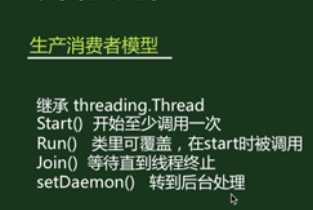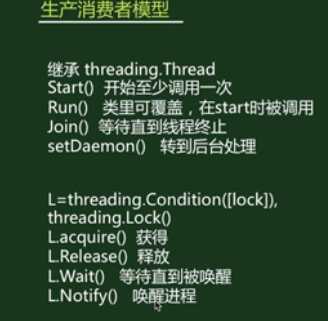标签:线程同步 java pytho 变量 消费者 and 数字 utf-8 read

1.不使用锁的话,可能会产生线程的竞争:当共享一个对象(变量或者一个方法)加锁的操作

在threading模块中,定义两种类型的琐:threading.Lock和threading.RLock。它们之间有一点细微的区别,通过比较下面两段代码来说明:
import threading
lock = threading.Lock() #Lock对象
lock.acquire()
lock.acquire() #产生了死琐。
lock.release()
lock.release()
import threading
rLock = threading.RLock() #RLock对象
rLock.acquire()
rLock.acquire() #在同一线程内,程序不会堵塞。
rLock.release()
rLock.release()
这两种琐的主要区别是:RLock允许在同一线程中被多次acquire。而Lock却不允许这种情况。注意:如果使用RLock,那么acquire和release必须成对出现,即调用了n次acquire,必须调用n次的release才能真正释放所占用的琐。threading.Condition
可以把Condiftion理解为一把高级的琐,它提供了比Lock, RLock更高级的功能,允许我们能够控制复杂的线程同步问题。threadiong.Condition在内部维护一个琐对象(默认是RLock),可以在创建Condigtion对象的时候把琐对象作为参数传入。Condition也提供了acquire, release方法,其含义与琐的acquire, release方法一致,其实它只是简单的调用内部琐对象的对应的方法而已。Condition还提供了如下方法(特别要注意:这些方法只有在占用琐(acquire)之后才能调用,否则将会报RuntimeError异常。):
Condition.wait([timeout]):
wait方法释放内部所占用的琐,同时线程被挂起,直至接收到通知被唤醒或超时(如果提供了timeout参数的话)。当线程被唤醒并重新占有琐的时候,程序才会继续执行下去。
Condition.notify():
唤醒一个挂起的线程(如果存在挂起的线程)。注意:notify()方法不会释放所占用的琐。
Condition.notify_all()
Condition.notifyAll()
唤醒所有挂起的线程(如果存在挂起的线程)。注意:这些方法不会释放所占用的琐。
在这里采用threading.Condition类的方法:但是这样太麻烦,后面采用Queen的方式:
1 #!/usr/bin/env python 2 #----coding:utf-8---- 3 ##python 下对生产者和消费者模型的理解 4 5 import threading 6 import random 7 import time 8 9 lock=threading.Condition() 10 11 class Produce(threading.Thread): 12 13 def __init__(self,lock,product,filename): 14 self._lock=lock 15 self.product=product 16 self.file=filename 17 threading.Thread.__init__(self) 18 def run(self): 19 while True: 20 if self._lock.acquire():##判断是否得到锁,类似于Java中lock1.lock 21 if (len(self.product)>100): 22 self._lock.wait() 23 else: 24 ##打印现在product数字,同时将其中IO写入txt文档 25 tmp=random.randint(0,10) 26 self.product.append(tmp) 27 28 print "add %d,product=%s: "%(tmp,str(self.product)) 29 30 ##通过IO口写入 31 fp=open(self.file,‘a‘) 32 fp.write("add %d, product = %s\n" %(tmp,str(self.product))) 33 fp.close() 34 self._lock.notify() 35 self._lock.release() 36 time.sleep(0.2) 37 38 class Consumer(threading.Thread): 39 def __init__(self,lock,product,filename): 40 self._lock = lock 41 self.product = product 42 self.file=filename 43 threading.Thread.__init__(self) 44 45 def run(self): 46 while True: 47 if self._lock.acquire(): 48 if len(self.product)== 0: 49 self._lock.wait() 50 else: 51 tmp = self.product[0] 52 del self.product[0] 53 print ‘consum %d, product =%s‘%(tmp,str(self.product)) 54 fp=open(self.file,‘a‘) 55 fp.write(‘consum %d, product = %s\n‘%(tmp,str(self.product))) 56 fp.close() 57 self._lock.notify() 58 self._lock.release() 59 time.sleep(0.1) 60 61 62 63 64 65 if __name__==‘__main__‘: 66 product=[] 67 ##假设product有五位:,消费者只有三位 68 for i in xrange(5): 69 p=Produce(lock,product,‘log_in.txt‘) 70 p.start() 71 72 for i in xrange(3): 73 T=Consumer(lock,product,‘log_in.txt‘) 74 T.start() 75 76
标签:线程同步 java pytho 变量 消费者 and 数字 utf-8 read
原文地址:http://www.cnblogs.com/woainifanfan/p/5837913.html